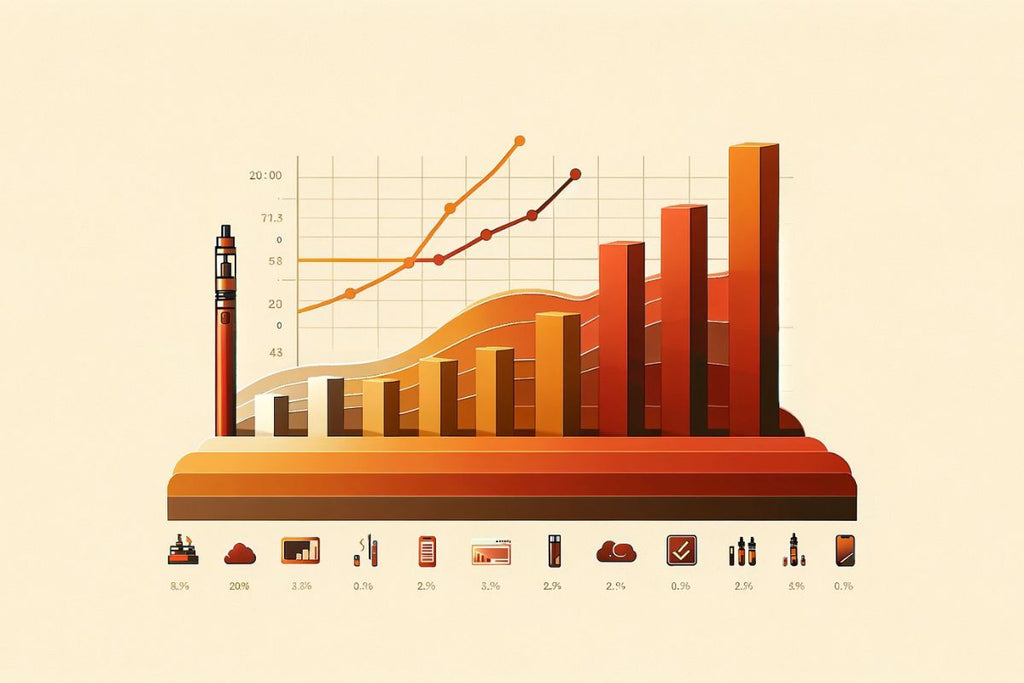
Vaping Statistics 2024: Surprising Figures & Facts Revealed
While 42% of Americans smoked in the middle of the 1960s, the percentage of people who used combustible tobacco products fell throughout the ensuing decades. The products that saw a gradual rise—vapes or e-cigarettes are frontrunners among them.
E-cigarette use is on the rise, particularly among teenagers and young people. These goods come in a variety of flavors and contain a variety of ingredients. The CDC says that 4.5% of people in the US use vaping or electronic cigarettes.
By the next year, the vaping market is expected to be worth $47.11 billion around the world. We will talk about more facts and statistics like this throughout the article. Read on to learn more.
Vaping: Definition and DetailsThe technical term for vaping is electronic nicotine delivery system (ENDS), which includes vape pens, pods, tanks, mods, and e-cigarettes. These gadgets replicate cigarette or cigar smoking by emitting aerosolized vapor instead of smoke. They use a heating element to evaporate a liquid (propylene glycol, glycerin, nicotine, and flavorings), which the user can inhale. |
Major Vaping Statistics in 2024

Vapers Are More Likely To Start Smoking
According to a new study published in the journal "JAMA Network OpenTeens," teens who begin vaping are roughly three times more likely to continue smoking cigarettes than their peers who do not use any form of tobacco product.
However, the study was unable to determine if vaping prompted the children to start smoking. However, the study authors discovered some rather robust links between vaping and eventual cigarette smoking.
Meanwhile, a Truth Initiative study found that young individuals who had ever used e-cigarettes had a sevenfold increased risk of becoming smokers one year later than those who had never vaped.
How Many People Have Died From Vaping?
Vaping has frequently been connected to sudden and serious lung issues, even deaths. E-cigarette, or vaping, product use-associated lung damage, or EVALI, is the term for this issue.
Up until February 2020, more than 2,800 users of e-cigarettes needed to be admitted to the hospital owing to EVALI; 68 of these individuals passed away, according to the CDC. The majority of instances were among teenagers and young adults.
How Many Cigarettes Are In A Vape?
Some of the most popular vapes on the market are advertised as coming in nicotine strengths of 0mg, 10mg, and 20mg/ml, so a 2ml vape typically contains 0, 20mg, or 40mg of nicotine and allows for between 600 and 800 puffs.
|
A 20mg/ml vape with 40mg of nicotine is therefore the equivalent of smoking one or two packs of 20 cigarettes. |
When a vape is illegal, it may contain a lot more e-liquid, and the strength per milliliter could be far higher than allowed. This means it offers thousands of puffs and is the equivalent of hundreds of cigarettes.
How Much Nicotine Is In A Vape?
Typically, vape nicotine levels range from 0 mg/mL to 50 mg/mL or higher. The milligrams per milliliter, or mg/mL, measurement indicates the amount of nicotine in the vape juice.
Lower nicotine levels, like 3 mg/mL or 6 mg/mL, are popular among ordinary e-liquids used in sub-ohm vaping, whereas higher levels, like 50 mg/mL, are typically found in pod systems or nicotine salt-based e-liquids.
How Long Has Vaping Been Around?
The search for a safer alternative to smoking cigarettes is the primary motivator behind the surge in vaping. In the 1950s and 1960s, when people started to hear about the dangers of smoking and the persistent odor of cigarette smoke, innovators started to think of ways to replace smoking.
Several pioneers in the vaping industry tried to bring their products to market in the middle to late 20th century; however, they were never successful; yet, they did add the word "vape" to the vocabulary.
Major developments in e-cigarette technology started happening in the 1990s.
|
In 2003, the first successful version of today's e-cigarettes was produced by Hon Lik, a Chinese pharmacist. After receiving the green light from regulators, electronic cigarettes hit the market in the United States in August of 2006 and Europe in April of 2006. |
How Many People Vape?
Vaping has become increasingly popular in recent years, with many people turning to e-cigarettes as a potential alternative to traditional smoking.
According to recent data from the Centers for Disease Control and Prevention (CDC), approximately 9 million adults in the United States currently use e-cigarettes.
This number has increased significantly over the past decade, with a sharp rise occurring between 2017 and 2018.
In 2017, there were approximately 2.8 million e-cigarette users in the U.S., but by 2018 that number had jumped to 3.6 million.
Check the data of vapers across the world throughout the previous years.
|
Year |
Number of People Vaping |
|
2013 |
2.6 million |
|
2014 |
3.7 million |
|
2015 |
4.2 million |
|
2016 |
5.3 million |
|
2017 |
6.2 million |
|
2018 |
7.3 million |
|
2019 |
8.5 million |
|
2020 |
30.55 million |
|
2021 |
55 million |
A Few Popular Vape (VapeDeal’s Top Picks)
|
Check out VapeDeal’s vape buying guide right here.
Some Fun Facts About Vaping In 2024

Check out some more fun facts about vaping here.
How Long Does A Nicotine Buzz Last?
Nicotine can take effect within 10 seconds of being inhaled. A vape or nicotine buzz can last from 10 to 30 minutes, depending on the user's tolerance. The longer someone consumes nicotine or vapes, the more tolerant they get of the adverse effects, and the shorter the rush lasts.
Why Were Vapes Invented?
The invention of vapes was driven by a multitude of factors.
The reasons behind its invention are similar to why people start vaping. The majority of users look forward to switching to vaping in an attempt to stop smoking, but a sizable proportion uses it recreationally or to bypass smoke-free rules.
Many people vape because they think it is safer than smoking. The variety of flavors and decreased cost compared to cigarettes are also major considerations.
Other motivations include less odor and fewer stains. E-cigarettes are also popular among technophiles who like customizing their devices.
Vaping Demographics
|
How Many Vapes Are Sold A Year?
According to a recent study by the CDC, the number of e-cigarettes sold each month rose by 46.6%, from 15.5 million in January 2020 to 22.7 million in December 2022.
Throughout this study, from 184 to 269 names, the number of brands rose by 46.2%. Prefilled devices went down in price, while throwaway devices went up. Flavors that appeal to teens and young adults, like fruit, candy, and desserts, also went up in sales.
Vape To Cigarette Ratio
Several factors, like the nicotine content of the e-liquid and an individual's vaping habits, make it difficult to calculate the number of cigarettes in a vape.
One milliliter of e-liquid containing 18 milligrams per milliliter is typically thought to be the same as roughly 20 cigarettes. This is just a ballpark figure, though, so don't take it as a definitive figure.
To provide an estimate, you can save over £4000 on average by switching to vaping every year.
Global Vaping Trends In 2024

Vaping is a global phenomenon at this point. Let’s check out the global usages and trends here.
The Top 10 Countries with the Highest Vape Usage |
|
|
United States |
4.5% |
|
United Kingdom |
7.1% |
|
France |
5.9% |
|
Canada |
6.5% |
|
Australia |
11% |
|
New Zealand |
12.5% |
|
Greece |
35% |
|
Italy |
7.8% |
|
Russia |
19% |
|
South Africa |
3.1% |
What about the lowest vape usages?
10 Countries with the Lowest Vape Usage |
|
|
Mexico |
0.1% |
|
Brazil |
0.8% |
|
Japan |
1.7% |
|
China |
1.2% |
|
India |
0.5% |
|
Poland |
3.4% |
|
Sweden |
2.7% |
|
Turkey |
0.9% |
|
Norway |
3% |
|
Denmark |
2.6% |
Here are some more global vaping insights
- Globally, there were 68 million e-cigarette users in 2020 (Harm Reduction Journal, 2021)
- By 2021, there were 82 million vapers, the majority of whom were from the Eastern Mediterranean region (Emerald Insight, 2023)
- The two biggest markets for vaping products between 2014 and 2018 were Western Europe and the United States (Tobacco Control Research Group, University of Bath, 2023)
The Global E-Cigarette Market Leaders |
|
|
|
The Global E-cigarette Market
By Product
- Modular Devices
- Rechargeable
- Disposable
By Distribution Channel
- Retail
- Online
The Monthly Cost Of Vaping
These days, you can get a beginner vape for a reasonable price. They vary in style and functionality but are easy to pick up and use.
The typical ranges of prices are:
- Costs $5-$10 for disposable vapes
- Costs $10- $30 for pod systems
- Costs $15–$35 for vape pens
- Costs $30–$60 for MTL starter kits
Some further vape costing insights-
- Smoking is more expensive than vaping. (Vaping Facts)
- It was anticipated that vaping products would be sold for $40 billion by 2023. (eClinicalMedicine)
- The typical monthly expenditure on vaping items and e-cigarettes is between $50 and $75. (National Library of Medicine)
- Compared to women, men spend more money on vaping goods. (National Library of Medicine)
- Spending less on vaping items every month is more likely for those who use e-cigarettes as a quitting tool. (National Library of Medicine)
- The annual cost of health care for all e-cigarette users is about $2,024. (Tobacco Control)
- Refillable e-cigarettes and e-juice average about $30 each week, whereas disposable e-cigarettes cost $20 on average (Alabama Cooperative Extension System)
When Did Vapes Become Popular?
In the United States, e-cigarettes first came out on the market in 2007. According to Euromonitor, a market study company based in London, there were about 7 million vapers around the world in 2011.
Over the years, the number of vapers grew quickly. In 2018, there were over 58 million vapers around the world. One prediction says that there will be about 82 million vapers in the world by 2021.
Why Do People Start Vaping?
A National Institute on Drug Abuse (NIDA) survey found that some individuals try vapes as a substitute for tobacco products when trying to quit smoking. According to research, about 60% of American adults who use electronic cigarettes also use them to cut back on or quit smoking altogether.
To avoid inhaling the toxic chemicals and tar from tobacco cigarettes, some individuals turn to vapes. Just one month after making the transition from smoking to vaping, more than 80% of participants in a research published in the Journal of Addiction Research & Therapy reported an improvement in respiratory function and general health.
Vaping is also popular for social reasons. Nearly a third of UK vapers who participated in a Vape Club study claimed they were inspired to give it a try after seeing it among friends or relatives.
Lastly, e-cigarettes have been reported to help alleviate anxiety and stress in certain users.
American Vaping Statistics

Organizations such as the American Vaping Association suggest that vaping can help reduce smoking habits. These vaping statistics in the United States reflect the country's vaping situation.
|
Teen Vaping Statistics

E-cigarettes and vapes are marketed with teens in mind, offering a variety of flavors, lower pricing, and concealable shapes and designs. Even though the legal purchasing age in the United States is 21, marketing is geared toward teenagers and young adults.
Check out the major teen vaping statistics
|
Vaping Age Statistics
Check out the number of vapers in different age categories.
|
Age |
Number of Vapers |
|
18-24 |
2.3 Million |
|
25-44 |
3.2 Million |
|
45-64 |
1.1 Million |
|
65+ |
0.2 Million |
Here are a few more interesting facts about vaping ages:
- The CDC reports that adults between the ages of 18 and 24 have the highest prevalence of e-cigarette usage, with 23.5% reporting current use.
- With 17.4% of adults in this age group reporting current use, those 25 to 44 had the second-highest prevalence of e-cigarette use.
- As people age, the prevalence of e-cigarette use declines; just 6.7% of people aged 65 and older report using them currently.
- Based on data from the NYTS, more than half of middle and high school students who reported smoking e-cigarettes in the previous month were in the age range of 15 to 17.
- According to the same dataset, about one-third of young people who use e-cigarettes are at least 18 years old.
Although adults are the ones who use e-cigarettes the most, more and more young people are starting to vape. A National Institutes of Health (NIH) study states that over 5 million middle and high school students in the United States reported using e-cigarettes in 2019.
Legal Vaping Age
In the UK and most of Europe, smoking or vaping requires a minimum age of 18. It is illegal to sell vape gear and supplies, including e-liquid refills, to anyone under 18.
The legal age to vape in the United States varies by state, ranging from 18 in the majority of the country to 19 on the West Coast and elsewhere, and 21 in select places, including California.
Vaping is prohibited in many Asian countries, including Singapore and Thailand, regardless of age.
Why Do High Schoolers Vape?
|
Economic Statistics Of Vaping

The global market for e-cigarettes was worth about USD 18.32 billion in 2022. It's expected to reach USD 46.98 billion by 2030, growing at a rate of about 12.49% per year from 2023 to 2030.
E-cigarettes are becoming more and more popular, but the industry is facing some problems and growth barriers. These problems are mostly caused by new studies about the safety of using vapes. However, the demand for e-vapes is expected to keep growing over the next few years, but it may face tougher limits than in previous years.
|
Here are some key insights-
|
Vaping Regulations And Policies
As the health effects of vaping become more clear, many jurisdictions, states, territories, and countries have begun enforcing vaping regulations.
These regulations can affect the buying and selling of vape products, as well as taxes, marketing, packaging, and more.
A Few Examples Vaping Regulations And Policies
|
Conclusion
Vaping is a global phenomenon, as millions of people use vaping devices with numerous flavors to satisfy their vaping needs.
Since a massive number of people, both in the US and worldwide, purchase vapes from different brands, the vaping industry has boomed over the last few years.
Vaping is significantly less expensive than smoking, and it also helps curb the smoking habit, so it also helps save a lot of money for people who are willing to quit smoking and kick their smoking habit.
This has made a lot of people take up vaping over the years, including a large number of young adults. While the reasons behind vaping may vary from person to person, the large demographic of vapers has ensured that the vaping industry keeps going ahead.
